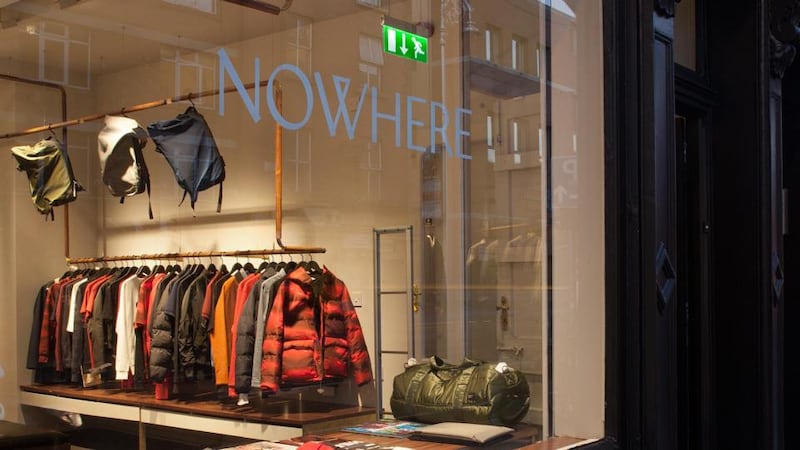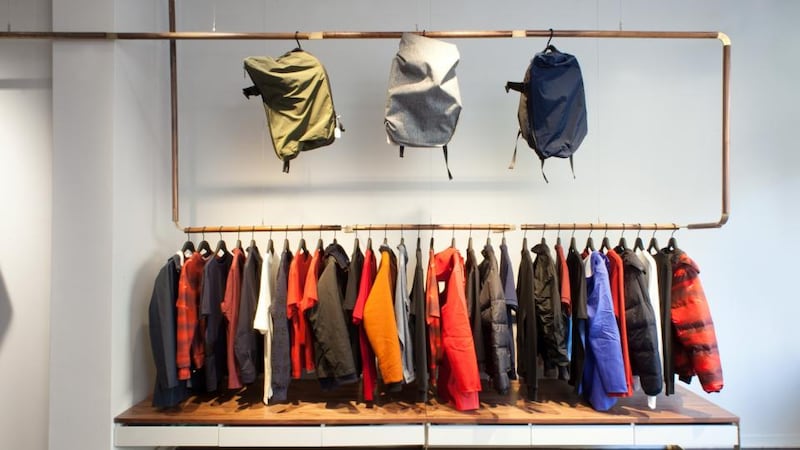The idea of thwarted manhood, outlined by US sociologist Michael Kimmel in his 2008 book Guyland, identified a growing trend among young, white, middle-class men unwilling to face conventional male responsibilities and who dress like inner-city African-Americans. Feeling a decline in their status and raised in a culture of instant gratification, these men find the idea of working for a future unappealing, Kimmel asserts.
What does this all have to do with a new menswear shop that has quietly opened on Aungier Street in Dublin? Its founders say that Nowhere was born of a shared interest in such discourses on modern masculinity and menswear. They say the shop is not just a retail project.
“We want to have collections that are forward-looking, thoughtful and fun,” says Brian Teeling, a stylist from Dublin’s northside who previously worked with Brown Thomas and Indigo & Cloth. “We want to promote a non-conformist alternative allowing men to express themselves more freely and be less confined by old ideals.”


Lesser-known labels
Their selection is aimed at fashion-savvy men frustrated by current menswear offerings in Dublin. They stock less well-known contemporary labels – all new to Ireland – that reformulate high fashion for men. Ambitious plans include online publications, and podcasts with academics, artists, designers and writers. In the meantime they have a collection of alternative magazines on fashion and art for sale.
The building, which dates back to the 1600s, has been stylishly designed and refitted with gallery-style lighting and copper lampshades in what used to be Maven.
“We wanted a different take on a gentlemen’s store, which is traditionally walnut and brass, with everything fixed,” says cofounder David Erixon, a Swedish-born entrepreneur who first came to Ireland to work for Vodafone. Architects ABGC of South Studios came up with an innovative, flexible walnut-and-brass clothing rail system that traverses the walls and can be reassembled into other formats. A handsome, heavy black leather curtain hangs at the entrance to the changing room. Storage is built in unobtrusively, including within the leather-covered bench, which sits centre stage.
The clothes have interesting stories to tell. The tweed coats with handpainted panels are by Irish designer Alan Taylor, an NCAD graduate who worked with Alexander McQueen; Christopher Raeburn reappropriates military fabrics sourced in Europe for his collection of parkas and hoodies; CMMN SWDN from Malmo mixes Scandinavian minimalism with international influences; and Stutterheim’s “Grandpa” rainwear draws on a traditional shape but in modern fabrics.
A handmade three-way quilted nylon briefcase with handles, strap and backpack attachment are from cult brand Porter from Japan, which dates back to 1936. “It epitomises our philosophy and how we buy, which has a craft focus rather than a faux heritage. It is forward-looking,” says Erixon.
According to Teeling, Irish men are getting a bit braver in the way they dress. He cites UFC fighter Conor McGregor as a masculine leader and talks about how he can pair a sharp trouser suit with a bun and takes an obvious interest in grooming and presentation.
However, what Teeling calls “normative masculinity” still holds sway – although it’s losing its grip, he argues – which in terms of dress is defined by guys trying to look like everybody else.
“It’s a shirt with lapels for no reason that is never tucked in and a black leather belt with washed-out boot-cut denims, which are too long and get walked on, over patent square-toed slip-ons with sports soles. There are four coat ideas in one peacoat and the No 1 rule is not to look like a sissy. If you were to parody the Prada look, that would be it.”
With socks that can be worn inside out, Fanmail T-shirts cut and sewn in Brooklyn from sustainable fibres and fabrics, and books about boys by girls, there is a lot going on in the shop that isn’t immediately obvious to the eye.
Nowhere is ambitious, and its aims – not to speak of its prices – are high, but its ideas are worth acknowledging.
“I don’t try to justify our prices, because our brands are all exclusive to us and the quality is high and we are working with new designers, 90 per cent of whom set up in the past five years. And we only carry one of every item in every size,” says Teeling.
Erixon fell in love with Dublin when he moved here six years ago, although, coming from Sweden, “the most equal [country] in terms of pay, power and education”, he finds Ireland more confining. “In Sweden you don’t dress for women and men are less defined by women. Here you have the church and the rugby, and such institutions are different in Sweden. We have such a strong women’s movement.”
Erixon, an authority on branding concepts, is the founder of the Hyper Island digital school with learning hubs all over the world and design agency Doberman operating in Europe and the US, although Dublin is his preferred home base.
He enthuses about Aungier Street and Dublin City Council’s plans for its development. “We are five minutes from BT and super-close to Portobello and Camden Street, and if you want to grow a city, you grow it from here. It could be such an amazing street if it was restored – there are big shopfronts on both sides. And it was Dublin’s first suburb.”
If Nowhere achieves anything it will be to encourage others to start creating more vitality on this historic street. “We promise to bring new things to Dublin and new ideas about masculinity. We will take risks and make bold bets,” says Erixon.
Nowhere, 64 Aungier Street, Dublin 2, anowhereman.com











